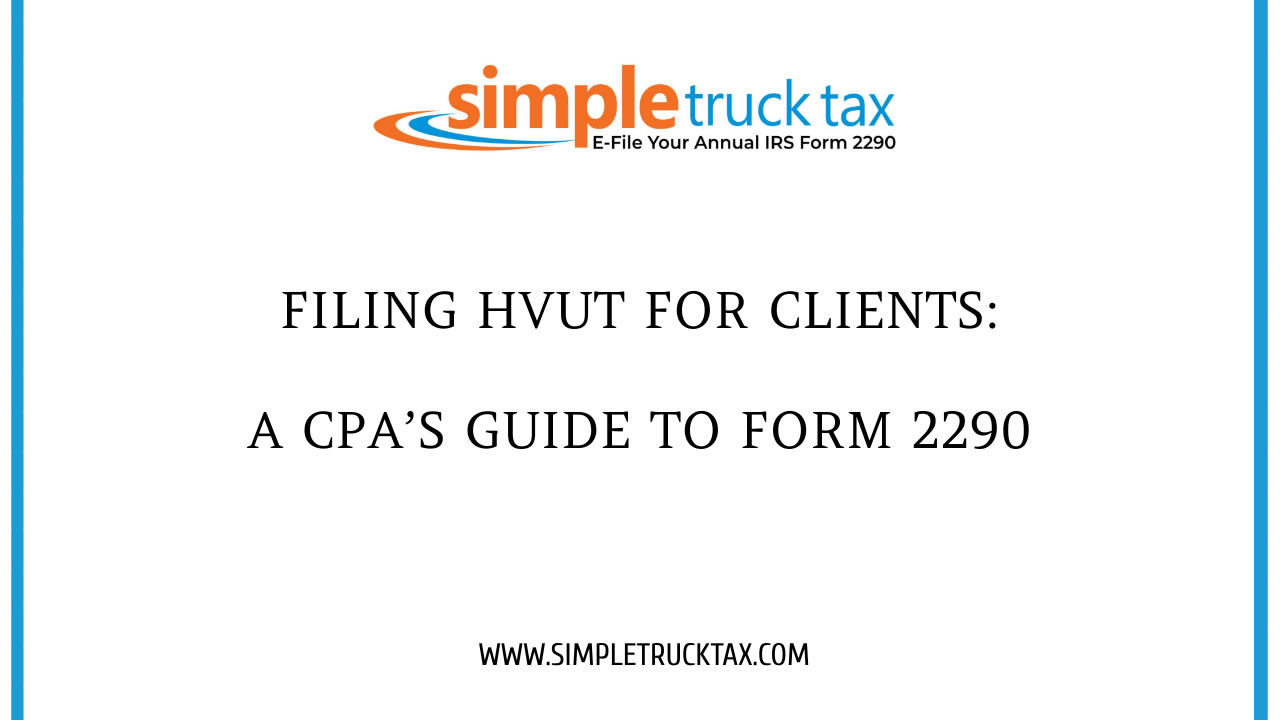10-02-2024
Filing HVUT for Clients: A CPA’s Guide to Form 2290
As a certified public accountant and involved with client activities in the transportation industry, you are responsible to help clients comply with federal tax obligations, namely Heavy Vehicle Use Tax (HVUT). The tax is specifically levied upon heavy vehicles using public highways, and the common form used for reporting and paying the tax is Form 2290. Knowing how to effectively help your clients navigate the process of filing will make you a more competent professional, but also help your clients to save their precious time and even penalties. End
HVUT stands for Heavy Vehicle Use Tax and is an annual tax imposed on vehicles that have a gross weight of 55,000 pounds or more that use the public highways. The funds generated from this tax are allocated to the Highway Trust Fund which finances the construction and maintenance of highways throughout the United States. The levy is determined based on the weight of the vehicle, the number of months in which the vehicle was used, and other exemptions regarding mileage. CPAs are mandated to ensure that the clients understand the implications of this levy and the requirement for accurate returns.
Important Due Dates and Filing Requirements
While counseling clients regarding HVUT, it would be useful to discuss the deadline. Form 2290 is usually filed by the last day of the next month after when the vehicle first starts usage. So, if one of your clients starts using a new heavy vehicle in August, this form should be filed with the IRS by September 30. A failure to file timely may attract penalties and even interest which can add up very fast. As a CPA you must maintain on file a calendar on which the dates are listed so you notify your clients, well before the deadline to make all necessary documents and monies available for payment.
Gathering Requirements
Gather all your client's information prior to filing Form 2290. Maintain a hitch-free process by: this involves;
- Vehicle Information: holding the Vehicle Identification Number, gross weight, and date of the first use of each heavy vehicle.
- Client Information: Collect the business name, address, and Employer Identification Number (EIN) of the client. It will be quite inconvenient if the details you collect are inadequate, especially for this form that will be required to be entirely accurate.
- Mileage Logs: If mileage logs are needed, it would first be determined whether your client would qualify for an exemption on mileage which would then extensively eliminate their tax amount.
With all the information available, this process of filing shall be smooth and the chances of errors minor ones that could lead to delays or an audit.
Step: Preparing and Filing Form 2290
Form 2290 can be filed through e-filing as well as paper-submission. It's much more preferable to file through e-filing due to the convenience it offers and the rapidity with which one gets answers in return. As a CPA, you can advise your clients to use the IRS-approved e-filing systems. In fact, you will find an instant confirmation most often after filing. Here's a quick view of the filing process .
- Obtain the Form: Get a copy of Form 2290 from the IRS website or any other e-filing facility you like.
- Form Fill-Up: Enter all information received with high precision. Scan all the VINs and clients' records nothing goes wrong.
- HVUT Tax Computation: The computation of HVUT is governed by the IRS. HVUT is computed based on the weight and usage of the automobile.
- Remit Payment: Clients make their payments of HVUT online and also check and money orders. Should be made aware of the due date to avoid penalty.
- onfirmation: Once you have submitted the form, obtain a confirmation of submission. This document has to be kept and may be required for auditing purposes in the future.
Payment Management and Record-Keeping
After you have successfully submitted Form 2290, educate your clients to handle their tax payments and maintain records. More importantly, remind them that they can obtain a copy of the submitted form as well as the confirmation of payment submitted in support of financial audit and tax return. On the same note, clients should maintain records of their vehicles and any communication letters exchanged with the IRS in respect of the HVUT.
Keeping Track of Changes in Tax Law
The tax law does change periodically, and therefore, any change in the law may alter the HVUT calculation and reporting for your clients. As a CPA, it is essential that you are always abreast of any changes or revisions in IRS guidelines that may impact your clients. Check the IRS publications regularly and attend professional development courses related to your areas of specialization.
That is to say, you will better serve your clients by keeping abreast of changes in tax law to keep your clients compliant with some minimised tax liabilities.
HVUT use tax filing for your clients BY using Form 2290, the CPA jobs of filing HVUT are considered very important for the transport industry. Only if you understand the complexities of this tax, adhere to key deadlines, and obtain accurate information to make informed decisions would you be able to provide invaluable support to your client. Guide them through the process while remembering that proactive communication, education, and a sharp eye for detail are essential in building trust and compliance. Best practices like these can help guide your clients through the often confusing world of HVUT, ensuring that they navigate it efficiently and effectively as well as stake a role on their financial journey.
Note: For more information, visit IRS website


